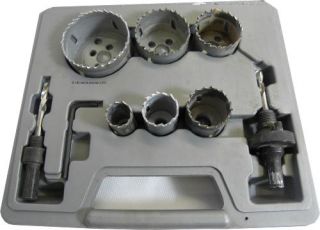Downlights and recessed spotlights are now becoming increasingly popular. Fitting these lamps is not too difficult and they can often make a room look very smart. These types of lights are available in mains voltage 240v or Low voltage (normally 12v) the low voltage ones will require a transformer and you may need several transformers depending on the total amount of lamps on the circuit. Please bear in mind that low voltage downlighters are not energy saving lamps, you need low wattage lamps to save energy.
| Before working on any electrical circuit you must ensure that it is isolated correctly and cannot accidentally be switched back on. Please read the article on safe isolation procedures before doing any electrical work. If you are not 100% certain what you are doing call a qualified electrician. Building regulations are changing all the time and modifying your home electrics could be against new rules and could invalidate your home insurance, if in doubt check first! |
Before fitting downlights you must ensure that you have adequate free ventilation around the fitting and that their use does not breech any fire regulations. The instructions with the down lights should give the required information.

This is the type of down lighter that we are going to be fitting. It is a standard 240v Version. If you were using Low voltage lamps you would have to push the transformer through the fitting holes.

Before marking out the positions of the lamps it is a good idea to check above the ceiling to ensure that there are no joists / wires / pipes in the way. The size of the down lighter is 80mm across and it is designed to be fitted into a 70mm hole and so I have drawn around the down lighter and then I have drawn a smaller circle on the inside. This ceiling is to be plastered and so I am making all the holes and routing the wires before the ceiling has been plastered.

Here I am using a plasterboard saw to cut out the required piece. I am only doing this to show that you don't need any fancy tools to do this.

Carefully cut out the holes in the ceiling, before doing this ensure that you are not cutting anything above the ceiling.

If you have lots of holes to cut, then it is worth buying a cheap set of hole saws. Do not buy an expensive set for drilling plaster or it will ruin them.

Now we have the required hole cut out from the plasterboard. We now need to feed the wires into these holes so that we can connect them to the downlights.
Downlights are wired in a radial circuit and so the feed wire goes to the first light in the circuit and then from the first to the second and then from the second to the third etc. When you get to the last light on the circuit the wire is terminated into the last light and so there will only be one wire at the last light fitting, as opposed to two at all the others.

Here we have two wires for the first light on the circuit. These two wires need terminating into a suitable connector and then the down light needs wiring into this also. You will notice that these wires are the old colours. Red - Live Black - Neutral The new colours are- Brown - Live Blue - Neutral

This is the last light on the circuit and as you can see there is only one wire. This will be terminated into a suitable connector and the last lamp on the circuit will be connected to this.

Some people call these a Chocbox and other people call them connector covers. These are ideal for this type of installation as they provide a good means of successfully connecting the cables. This is the last light on the circuit and so there is only one circuit wire. All the other lights will have two circuit wires, wired into the chocbox. The cables are held in place at each end by the cord grips and then wired into the connector strip. The downlights that I am fitting do not require an earth and so I have terminated the earth into a spare terminal. Do not cut the earth off as it may be needed if you ever replace the lights.








